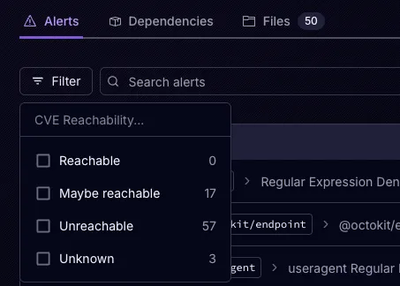
Product
Introducing Rust Support in Socket
Socket now supports Rust and Cargo, offering package search for all users and experimental SBOM generation for enterprise projects.
Utility for warping GIS-like triangular meshes to fit a projection; meant for helping WebGL raster reprojection.
A tool for subdividing triangular meshes for GIS reprojection purposes.
See https://ivan.sanchezortega.es/development/2021/03/08/introducing-arrugator.html
The inputs are:
projector function (which takes an Array of 2 Numbers, and returns an Array of 2 Numbers). Typically this is meant to be a proj4js forward projection function, like proj4(srcCRS, destCRS).forward; however, arrugator has no hard dependency on proj4js, so other projection methods could be used.Array of Arrays of 2 Numbers, typically NW-SW-NE-SE)Array of Arrays of 2 Numbers, typically [[0,0],[0,1],[1,0],[1,1]])Array of Arrays of 3 Numbers, typically [[0,1,3],[0,3,2]]).Note that the typical input is four vertices, but there's no hard requirement on that. Any triangular mesh should do (and maybe there are edge cases I haven't think of where it's required so things work for weird projections like polyhedral ones).
And the ouputs are:
Array of Arrays of 2 Numbers)Array of Arrays of 2 Numbers)Array of Arrays of 2 Numbers)Array of Arrays of 3 Numbers).Initialize some data (assuming proj4 has already been set up):
// These are the corner coordinates of a Spanish 1:2.000.000 overview map in ETRS89+UTM30N:
let epsg25830coords = [
[-368027.127, 4880336.821], // top-left
[-368027.127, 3859764.821], // bottom-left
[1152416.873, 4880336.821], // top-right
[1152416.873, 3859764.821], // bottom-right
];
let sourceUV = [
[0, 0], // top-left
[0, 1], // bottom-left
[1, 0], // top-right
[1, 1], // bottom-right
];
let arruga = new Arrugator(
proj4("EPSG:25830", "EPSG:3034").forward,
epsg25830coords,
sourceUV,
[
[0, 1, 3],
[0, 3, 2],
] // topleft-bottomleft-bottomright ; topleft-bottomright-topright
);
Then, subdivide once:
arruga.step();
Or subdivide several times:
for (let i = 0; i < 10; i++) {
arruga.step();
}
Or subdivide until epsilon is lower than a given number (square of distance in map units of the projected CRS - in this example, EPSG:3034 map units):
arruga.lowerEpsilon(1000000); // 1000 "meter"s, squared
If there are antimeridian artefacts, or an "epsilon stall" warning appears on your console, you might want to "force" subdividing every segment before running the default subdivisions:
arruga.force();
Once you're happy with the subdivisions, fetch the mesh state:
let arrugado = arruga.output();
let unprojectedCoords = arrugado.unprojected;
let projectedCoords = arrugado.projected;
let uvCoords = arrugado.uv;
let trigs = arrugado.trigs;
The output are Arrays of Arrays, so the use case of dumping the data into a TypedArray to use it in a WebGL buffer needs them to be .flat()tened before.
How to do this depends on how you're usign WebGL (or what WebGL framework you're using). For example, my glii examples work like:
const pos = new glii.SingleAttribute({ glslType: "vec2", growFactor: 2 });
const uv = new glii.SingleAttribute({ glslType: "vec2", growFactor: 2 });
const indices = new glii.TriangleIndices({ growFactor: 2 });
pos.setBytes(0, 0, Float32Array.from(arrugado.projected.flat()));
uv.setBytes(0, 0, Float32Array.from(arrugado.uv.flat()));
solidIndices.allocateSlots(arrugado.trigs.length * 3);
solidIndices.set(0, arrugado.trigs.flat());
wireIndices.allocateSlots(arrugado.trigs.length * 3);
wireIndices.set(0, arrugado.trigs.flat());
See the demo branch of this git repository; there are some glii-powered examples there, including demo raster data.
LineArrugatorThere is also LineArrugator, a lightweight form of Arrugator designed to work
on segment lists ("polylines") instead of working on triangle meshes.
The input is just a list of [x,y] coordinates, and the output is another list of
[x,y] coordinates, projected.
let arruga = new LineArrugator(
proj4('EPSG:4326','EPSG:25830').forward,
[[-50, 0], [40, 25]]
);
arruga.lowerEpsilon(10000);
console.log(arruga.output());
Released under the General Public License, v3. See the LICENSE file for details.
FAQs
Utility for warping GIS-like triangular meshes to fit a projection; meant for helping WebGL raster reprojection.
The npm package arrugator receives a total of 1 weekly downloads. As such, arrugator popularity was classified as not popular.
We found that arrugator demonstrated a not healthy version release cadence and project activity because the last version was released a year ago. It has 0 open source maintainers collaborating on the project.
Did you know?

Socket for GitHub automatically highlights issues in each pull request and monitors the health of all your open source dependencies. Discover the contents of your packages and block harmful activity before you install or update your dependencies.

Product
Socket now supports Rust and Cargo, offering package search for all users and experimental SBOM generation for enterprise projects.

Product
Socket’s precomputed reachability slashes false positives by flagging up to 80% of vulnerabilities as irrelevant, with no setup and instant results.

Product
Socket is launching experimental protection for Chrome extensions, scanning for malware and risky permissions to prevent silent supply chain attacks.